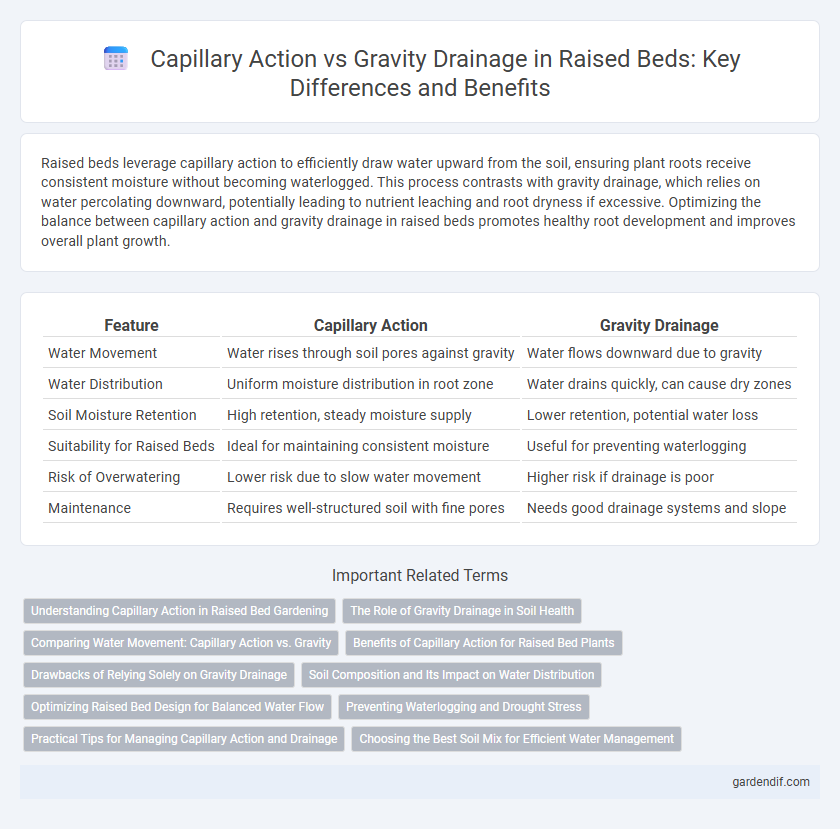
Capillary action vs Gravity drainage Illustration
Raised beds leverage capillary action to efficiently draw water upward from the soil, ensuring plant roots receive consistent moisture without becoming waterlogged. This process contrasts with gravity drainage, which relies on water percolating downward, potentially leading to nutrient leaching and root dryness if excessive. Optimizing the balance between capillary action and gravity drainage in raised beds promotes healthy root development and improves overall plant growth.
Table of Comparison
| Feature | Capillary Action | Gravity Drainage |
|---|---|---|
| Water Movement | Water rises through soil pores against gravity | Water flows downward due to gravity |
| Water Distribution | Uniform moisture distribution in root zone | Water drains quickly, can cause dry zones |
| Soil Moisture Retention | High retention, steady moisture supply | Lower retention, potential water loss |
| Suitability for Raised Beds | Ideal for maintaining consistent moisture | Useful for preventing waterlogging |
| Risk of Overwatering | Lower risk due to slow water movement | Higher risk if drainage is poor |
| Maintenance | Requires well-structured soil with fine pores | Needs good drainage systems and slope |
Understanding Capillary Action in Raised Bed Gardening
Capillary action in raised bed gardening enables water to move upward through soil pores, delivering moisture directly to plant roots for efficient hydration. This natural process contrasts with gravity drainage, which relies on water moving downward and can lead to nutrient loss if excessive. Optimizing soil texture and organic matter in raised beds enhances capillary action, promoting healthier plant growth and conserving water.
The Role of Gravity Drainage in Soil Health
Gravity drainage plays a crucial role in maintaining soil health in raised beds by facilitating the downward movement of excess water, preventing waterlogging and root oxygen deprivation. Effective gravity drainage ensures optimal soil aeration, promoting robust root growth and microbial activity essential for nutrient cycling. Properly designed raised beds leverage gravity drainage to balance moisture retention and prevent harmful conditions such as soil compaction and anaerobic environments.
Comparing Water Movement: Capillary Action vs. Gravity
Capillary action in raised beds enables water to move upward and laterally through soil pores, ensuring consistent moisture availability to plant roots, especially in finer-textured soils. In contrast, gravity drainage relies on the downward pull of water through larger soil pores, rapidly removing excess water but potentially leading to dry upper layers. Understanding the balance between capillary action and gravity drainage is crucial for optimizing irrigation strategies and preventing waterlogging or drought stress in raised bed gardening.
Benefits of Capillary Action for Raised Bed Plants
Capillary action in raised bed gardening allows water to move efficiently from the soil's lower layers to the root zone, ensuring consistent moisture availability for plants. This natural process reduces water waste and minimizes the risk of overwatering, promoting healthier root development and reducing stress on the plants. In contrast to gravity drainage, capillary action supports optimal soil aeration and nutrient uptake by maintaining balanced moisture levels critical for plant growth.
Drawbacks of Relying Solely on Gravity Drainage
Relying solely on gravity drainage in raised beds can lead to uneven moisture distribution, causing water to drain too quickly and depriving plant roots of consistent hydration. This method often results in waterlogging at the bottom while the upper soil layers dry out, negatively affecting root health and nutrient uptake. Incorporating capillary action through appropriate soil composition enhances moisture retention and ensures more balanced water availability for plants.
Soil Composition and Its Impact on Water Distribution
Soil composition significantly influences water distribution in raised beds through capillary action and gravity drainage. Sandy soils promote gravity drainage due to large pores allowing rapid water passage, while clay-rich soils enhance capillary action by retaining moisture in smaller pore spaces. Balanced loam soils optimize both mechanisms, ensuring adequate water retention and drainage for healthy plant growth.
Optimizing Raised Bed Design for Balanced Water Flow
Optimizing raised bed design for balanced water flow involves leveraging capillary action to draw water evenly throughout the soil while ensuring effective gravity drainage to prevent waterlogging. Incorporating well-structured soil with appropriate organic matter and particle size enhances capillary water movement, promoting root hydration. Simultaneously, designing beds with proper slope and drainage layers facilitates excess water removal, maintaining ideal moisture levels for plant health.
Preventing Waterlogging and Drought Stress
Capillary action in raised beds ensures even moisture distribution by drawing water upward through soil pores, preventing drought stress by supplying roots with consistent hydration. Gravity drainage facilitates excess water removal, reducing the risk of waterlogging and root rot in raised beds with well-structured soil. Balancing capillary action and gravity drainage optimizes soil moisture levels, promoting healthy plant growth and preventing stress from both oversaturation and dryness.
Practical Tips for Managing Capillary Action and Drainage
Capillary action draws water upward to plant roots, promoting consistent moisture levels, while gravity drainage removes excess water to prevent root rot. To optimize raised bed health, layer coarse materials like gravel or coarse sand beneath soil to enhance drainage and mix organic matter to improve moisture retention. Installing a wicking system can boost capillary action by supplying water directly to roots, balancing hydration without waterlogging.
Choosing the Best Soil Mix for Efficient Water Management
Capillary action draws water upward through soil pores, providing consistent moisture to plant roots, while gravity drainage ensures excess water moves downward, preventing waterlogging. Selecting a soil mix with balanced particle sizes, like a blend of loam, sand, and organic matter, optimizes both mechanisms by enhancing water retention and improving drainage. Efficient water management in raised beds relies on this harmony to maintain healthy root environments and reduce plant stress.
Capillary action vs Gravity drainage Infographic

 gardendif.com
gardendif.com